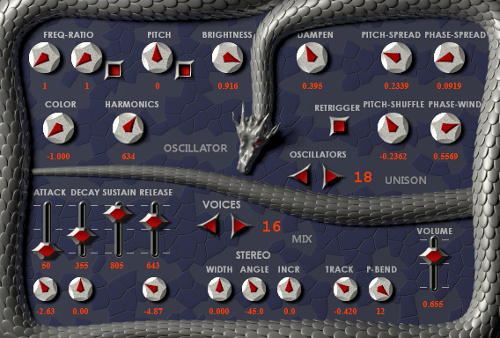Sonitarium
v1.3 VST
|

Download
Sound
demo video: One instance of
Sonitarium playing, no effects, constantly changing controls.

|
|
Introduction
Sonitarium employs a variant of DSF synthesis with
aliasing-free oscillators that generate a quadrature stereo
signal. Providing up to 200 oscillators per voice, Sonitarium is most
suitable for fat pads, drone sounds, and horror music.
Sonitarium was made using Synthedit.
The sound engine isn't
based on native Synthedit modules, though, but newly coded
in C++.
Features
- Aliasing-free DSF
oscillators, each generating a
quadrature
stereo signal.
- Up to 200 oscillators
per voice. Unison controls to
alter
the pitches and phases of the oscillators.
- Freely selectable
polyphony with up to 16 voices.
- Text field input for
all controls.
- Envelope and key
tracking controlled volume.
Adjustable
pitch bend range.
- Freely adjustable
Attack, Decay, and Release slopes.
- MIDI control of all
parameters (CC).
- 92 presets.
How
it
works
Feel free to read my article The
Math behind DSF
Synthesis if you're interested
in knowing how the synthesis
of Sonitarium works.
Controls
The interface is divided into three sections: Oscillator, Unison,
and Mix.
In the Oscillator
section,
the
general oscillator settings can be specified. In the Unison
section, you
can
specify how many oscillators shall be used per voice and how to
detune them. The Mix
section, again, basically controls volume and stereo.
Whereas control changes in the Oscillator
section affect all
oscillators, control changes in the Unison
section only
have an audible
effect if at least two oscillators per voice are used. Besides,
control changes in the Oscillator
and Unison
section don't affect the
voices that are currently playing. Instead, a control change will
affect only the next played note and the notes after that. So
when you automate the Oscillator
and Unison
controls, many voices with
different parameters may play at the same time. In contrast,
control changes in the Mix
section immediately affect all
voices currently playing.
All continuous controls have text entry fields which you can use
to enter values - just click on them and type, or use copy &
paste. The sliders can be moved with more precision when you
press CTRL while moving them. And to turn the knobs with more
precision, click on them, then move the mouse pointer away while
keeping the mouse button pressed; the farther away the mouse
pointer is, the more precise the knob will be.
Oscillator
The knobs in the Oscillator
section have the
following meaning:
- Harmonics:
This
determines how many harmonics each oscillator generates.
There is rarely an audible difference between, say, 500 and
1000 used harmonics. If the amount drops below 100, though,
the difference is getting more significant.
- FreqRatio:
These two
knobs determine the distance between two neighbored
harmonics, the frequency fr.While
the
fundamental
frequency fc is
specified by the
currently
played note and the Pitch
settings, fr
is computed as
fr
= fc
* left /
right, where "left" is the value of the left knob, "right" is
the value of the right knob.
Well, forget the math and try it. For example, a 1:1
ratio generates saw-like sounds, a 2:1 ratio generates
square-like sounds.
With the button next to the knobs you can control whether the
values are rounded (which makes the sound more harmonic)
or not.
- Pitch:
Alters the
pitch, measured in octaves. That is, a value of 1 means that
the note is played one octave higher. With the button next to
the knob, you can control whether the value is rounded.
- Brightness:
This is
the rate by which the magnitude of the harmonics drops off
from the fundamental frequency. Low values make the sound
dull, high values make the sound bright.
- Color:
If this knob
is in its leftmost position, the harmonics will be on the
"left" side of the fundamental frequency only, ie. in the
lower frequency range. If the knob is in its middle position,
harmonics will be on both sides of the fundamental. And if
it's in its rightmost position, the harmonics will be on the
right side of the fundamental frequency only. Turning the
knob to intermediate positions will continuously mix between
those states.
Unison
The knobs in the Unison
section have the following
meaning:
- Oscillators:
The
amount of oscillators used per voice. From 1 to 100.
- Dampen:
When there
are many oscillators running, the upper frequencies may sound
harsh at times. This control dampens that effect. Use Dampen
together
with Brightness
to give
the sound the right tone.
- Pitch-Spread:
Controls the range within which the pitches of the
oscillators are spread. At 0, all oscillators have the same
pitch. At 1, there dissonance is at maximum.
- Pitch-Shuffle:
Controls how the pitches are spread. At 0, they are spread
evenly. Approaching -1 or 1, the pitches are condensed at
certain spots.
- Phase-Spread:
Controls the initial phases of the oscillators. At 0, all
oscillators start with the same phase (when many oscillators
are used, this causes a high pitched resonance sound).
Approaching 1, the intial phases are spread more and
more (basically, this weakens the resonance sound and makes
pads more smooth).
- Phase-Wind:
To
understand this control, you best view it as a sort of
time-machine that changes the initial phases defined with Phase-Spread.
At 0,
the initial phases are not changed. Approaching 1, the phases
are "winded forward", as if the current note has already been
playing for a while. Approaching -1, the phases are rewinded,
ie. the initial phases are extrapolated towards the past.
This is not a real forward or backward winding effect,
though, because it always acts as if Phase-Shuffle
was
set to 0 (that
is, it is real forward or backward winding if and only if Phase-Shuffle
is
0).
The effect becomes most audible if you have an evolving
sound.
- Retrigger:
If this
is switched on, then the oscillator phases get reinitialized
each time a note is played. If this is switched off, then
each newly triggered voice inherits the oscillator phases
from the last played voice. You may want to use this to make
pads extra smooth, or to make a sound that keeps evolving
while playing new notes.
Mix
The knobs in the Mix
section have the following
meaning:
Envelope
Settings
- Attack,
Decay,
Sustain,
Release:
Just the same old
volume envelope settings. Below Attack, Decay, and Release,
there are additional knobs which can be used to alter the
slopes if the respective curve.
Stereo
Settings
- Width:
This control
works different than the Width
control in Tetra.When
the
knob is at 0, the harmonics
are out of phase by 90 degrees (all cosines on the right, all
sines on the left). At -1, you get a mono signal (only the
left channel). At 1, it's mono as well (only the right
channel).
- Angle:
Angle by
which the stereo image is rotated.
- Incr:
The angle by
which the stereo image is rotated further every time a note
is played. At -90 and 90 degrees, left and right channel will
be swapped with every note.
Notice that Angle
and Incr
don't
have an effect if Retrigger
is switched off.
Miscellaneous
- Voices:
The maximum
amount of voices that can be active at the same time. It can
be freely set between 1 and 16.
- Track:
Turned to the
left, lower notes get emphasized. Turned to the right, higher
notes get emphasized.
- Bend:
This is the
pitch bend range measured in half tones. If you're using a
pitch bend wheel, you may have to alter this parameter to get
the desired effect.
- Volume:
Limits the
overall volume.
MIDI
Control
Mapping
This table shows to which MIDI CCs the controls are
mapped
| PhaseWind |
1 |
Track |
23 |
| PhaseSpread |
2 |
Brightness |
24 |
| Width |
8 |
Dampen |
25 |
| Volume |
11 |
Harmonics |
26 |
| PitchSpread |
12 |
RatioM |
27 |
| PitchShuffle |
13 |
RatioC |
28 |
| AttackS |
14 |
Pitch |
29 |
| DecayS |
15 |
Color |
30 |
| Attack |
16 |
Voices |
76 |
| Decay |
17 |
Oscillators |
77 |
| Sustain |
18 |
Bend |
78 |
| Release |
19 |
PRound |
80 |
| ReleaseS |
20 |
FRound |
81 |
| Angle |
21 |
Retrigger |
82 |
| AngleIncr |
22 |
|
|
Installation
Put the file Sonitarium.dll into your VST Plugins
folder.
Version
History v1.3a: Fixed problem preventing the plugin from working with Windows XP.
v1.3:
- Upgraded to Synthedit1.1.
- New Skin.
- Increased maximum number of oscillators from 100 to
200.
- 10 new presets.
v1.2:
- About 40% less CPU
drain (only on systems supporting SSE2
instructions, eg. Pentium4, Athlon64 or later).
- Fixed crackling noise
when running multiple synth instances
on multi-core systems.
- 22 new presets by
runagate.
- Fixed potential
pops and sticking notes.
- Limited the maximum
generated frequency to 21kHz even at
sample rates greater than 44.1kHz to avoid volume change at different
sample rates.
- Downward compatible to
v1.0/v1.0a.
v1.0a: Fixed retrigger bug when "retrigger" was set to off.
v1.0: Initial Release.
Thanks
Thanks to runagate
for his presets.
Contact
You can contact me by E-Mail at: moppelsynths@verklagekasper.de
(Burkhard Reike).
DISCLAIMER:
This software is provided as is, there is no warranty and
nobody is responsible for any kind of damage. Use it at your own
risk.
VST is a trademark of Steinberg Soft- und Hardware GmbH,
Germany.
|



